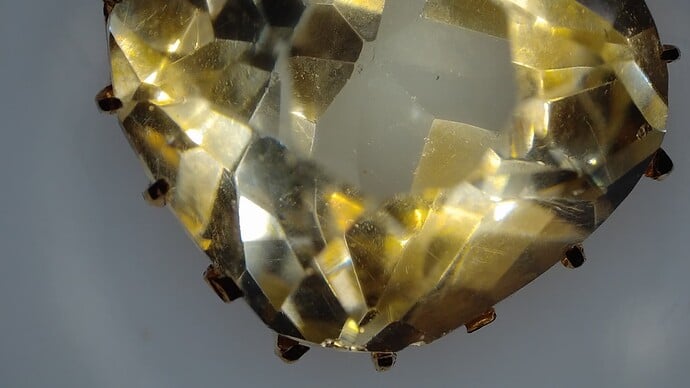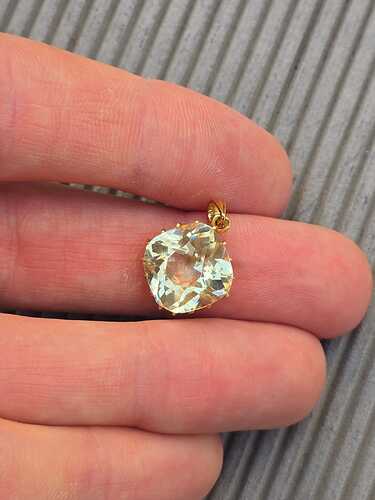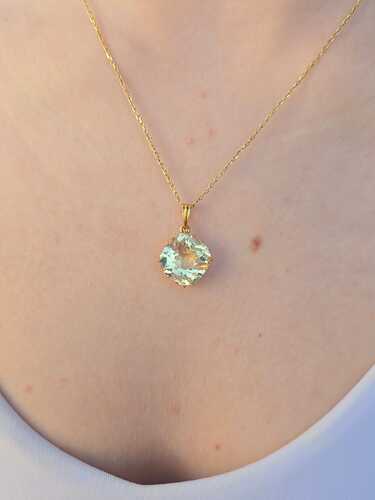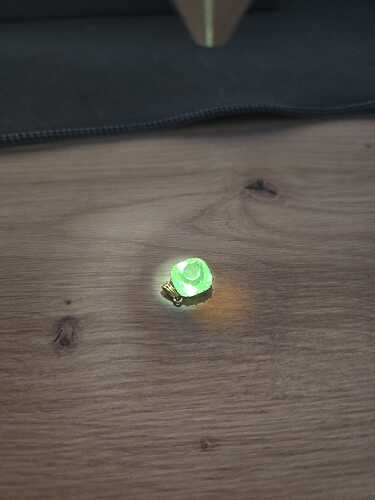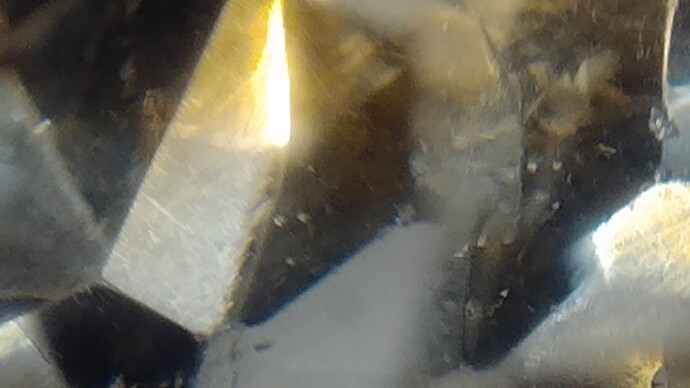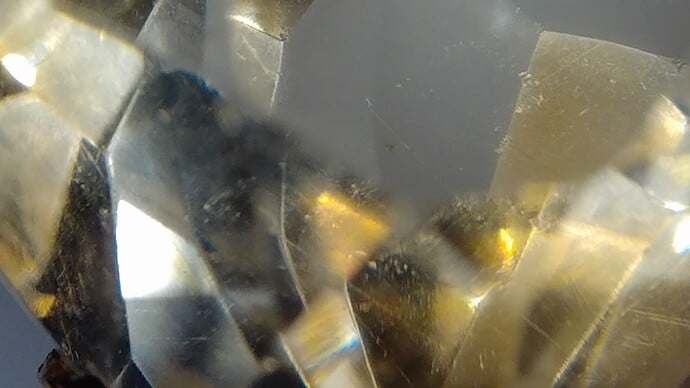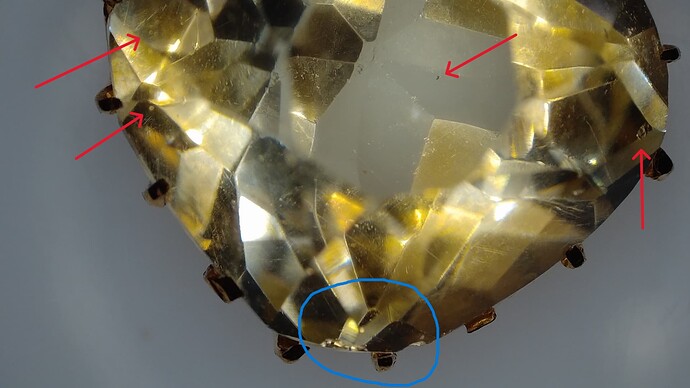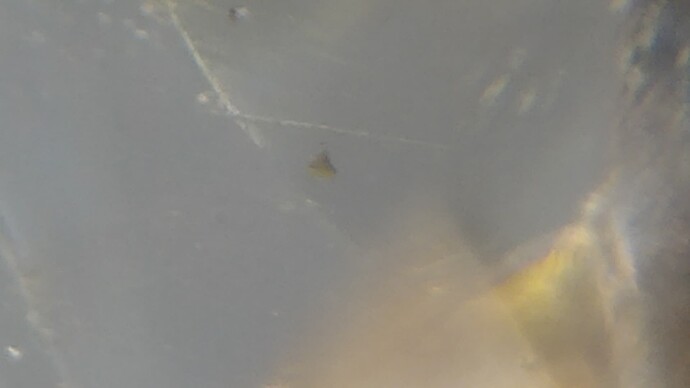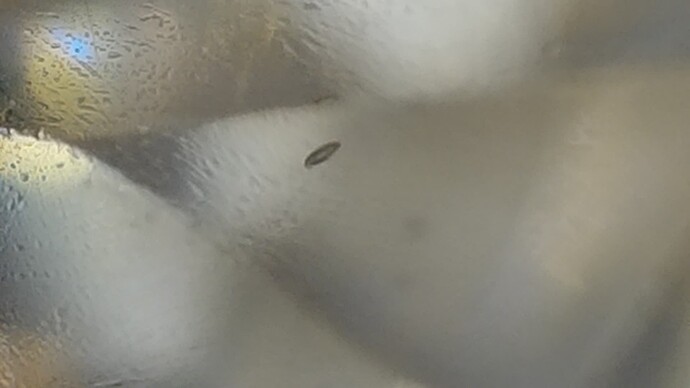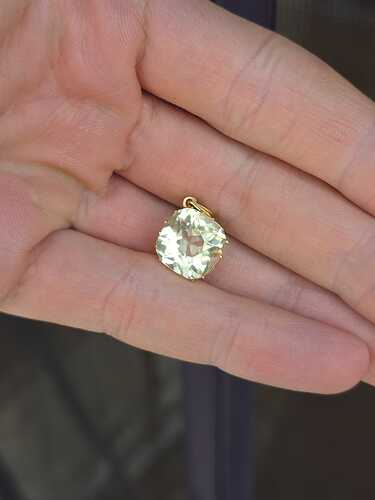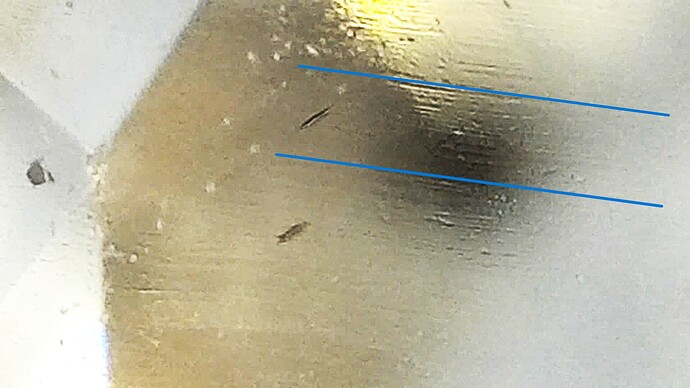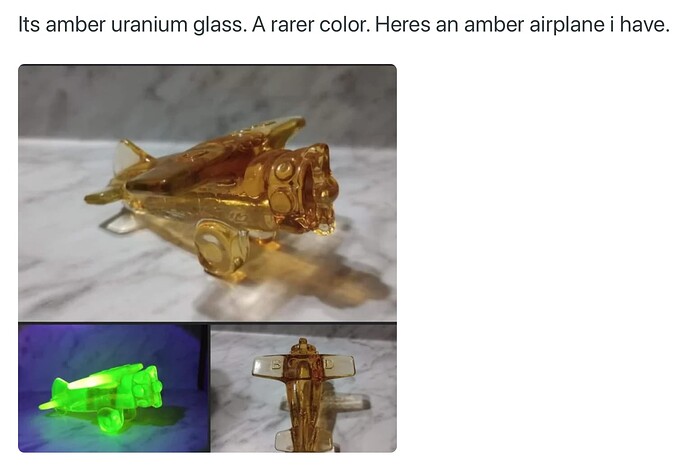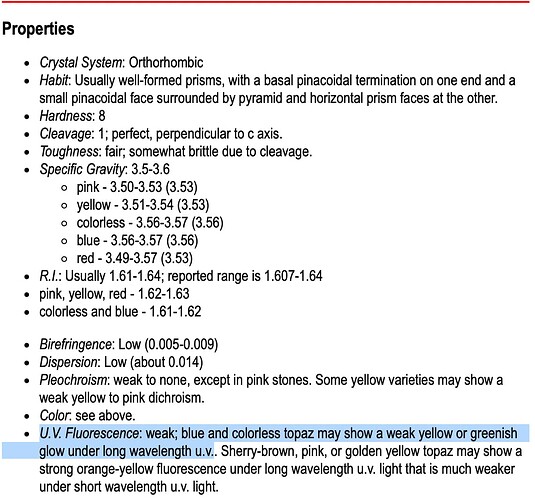I bought a pendant with 18kt gold and a 9ct unknown greenish yellow gemstone refractive index is 1.639 -1.649, by rotatin the polarised lens, it doesn’t move. On the UV light it goes green and there is a small inclusion i got under the microscope. I am between tourmaline and topaz but none of them respond like that under UV light. Thanks!
Observations:
-
The stone seems to have scratches and some dull facet joints. Could be a softer stone with a lower hardness and durability than Topaz.
-
The stone has a central window indicating a low quality cut.
-
Color change seems to happen from the different lighting conditions, which could be the stone fluorescing stronger with green from sunlight, versus indoor lighting.
-
Sherry/Yellow-brown Topaz doesn’t normally fluoresce yellow-green but rather orange-yellow.
-
Topaz is Biaxial+. I suspect you should see some change in the RI measurements using the polarizing filter, but may require measuring the RI in a few more directions to be sure. Since the stone is still in its setting, I assume the RI was only taken on the table facet?
-
It is difficult to see the inclusion mentioned. Is it in image:2025_0606_203501?
I would have suggested Scapolite as a possible species, but the RI doesn’t fit.
A polariscope would help determine the optical sign. Using a dichroscope would help determine pleochroic behavior. And a Specific Gravity test would help determine if it is in range of Topaz / Tourmaline since they overlap or it could reveal a different group altogether.
It is very hard to identify a stone with images alone, but you have posted some information that is helpful! ![]() Thank you!
Thank you!
Cheers!
Hello, thanks again for replying to my posts. 1.Yes the durability is lower than a garnet,at least with the most basic tester there is. 2. The gemstone has 9ct, I think the cut is not that bad. 3. Good point! I think you’re right. inside the gem is yellow, outside it’s greenish yellow. 5. I see little to no movement with the polarising lens. and Yes I took only the table facet. Today I tested it also on the crown face and it came 1.62 6. I put another photo with the inclusion.
Hi Tudor,
Looking at the stone images a bit more…
The yellow/gold color seen in the indoor images could be reflections coming from the metal of the pendant centerpiece and may not be the natural hue of the stone.
I’m not sure which inclusion you are pointing out in the images. So I went back and looked at 2025_0606_203354_001 from the original post and identified several that are under some of the crown facets. Are these what you are asking about?
Found what appears to be some irregular mineral specks in the center and right side (red arrows). Several bubble-like inclusions are on the left side (also red arrows), and there is a chip on the girdle, located in the blue circle. There are some additional angular lines near the table that I am not sure if they are inclusions or surface features.
I am thinking the cut of the stone was not done for optimal clarity but rather for weight retention. Without the critical angles being used, the stone is displaying a large windowed volume. This doesn’t mean it is a badly cut stone, it is just not optimal and diminishes the stone’s potential brilliance.
Cheers!
Made some more Photos with some inclusions I found inside. What you pointed on the left, they are chips outside.
Thanks for the new images. There does seem to be some mineral and finger-print type inclusions.
Did some “photoshop-ish” enhancements to image 2025_0609_121830_003 to detail what appears to be striae (growth lines).
Here is the image:
I am seeing some curvature to the growth lines which would indicate the stone is synthetic.
So it’s a syntetic tourmaline with crystal inclusions? ![]()
Hi Tudor,
Currently we don’t have any concrete evidence that it is or isn’t synthetic. The lines in the image I enhanced, have a curved shape. However, there are optical aberrations that could explain the phenomenon. This is a common problem using ultra-wide and wide-field camera lenses.
The presence of what looks like mineral inclusions could debate the notion it is a flame-fusion synthetic material. However, some synthetic spinel has shown mineral inclusions and curved striae. I have been searching for literature that argues both sides to get better context.
Tourmaline is still on the radar, but without further diagnostics, we don’t know what the species is.
An article describing common synthetic materials and processess:
In the magnified photo, the lines on the stone look to me like they are on the surface…abrasion lines from cutting that weren’t completely polished off. The slight curvature could be a result of the lines coming from a circular lap. Curved striae I have seen in other photos are clearly inside the stone. Just my take. As far as tourmaline, if it were that, I think you’d see pretty clear dichroism with a dichroscope. -royjohn
Roy, that is a good point! Those lines could be the on the surface. Tudor could verify that rather quickly using reflected light off the facet surfaces under magnification. Thanks! Always appreciate your insight!
-Troy
I think those lines are outside.
Uranium glass has 1.53 RI. This did go between 1.62 and 1.64
Unfortunatelly I have no dichroscope
Perhaps just a rare topaz -
https://www.geo.utexas.edu/courses/347k/redesign/Gem_Notes/Topaz/topaz_main.htm
Hi Tudor! It might be scapolite. I do not think it’s tourmaline.
Can scapolite reach this RI? How do I make sure of the diagnosis?
You can read this article
https://www.reddit.com/r/Shinypreciousgems/comments/vhi9v9/educational_post_all_about_scapolite/
Plus tourmaline is inert to uv light.
It’s a very interesting stone for sure.
You can also find more info here:
